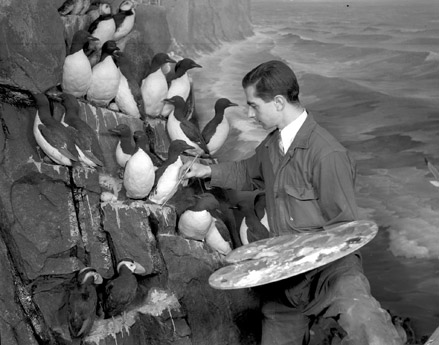
Raymond deLucia painting bird droppings on the artificial rocks in the Little Diomede Island diorama in the Whitney Memorial Hall of Pacific Bird Life (1939). AMNH ©
Taxidermy, which is the act of preparing, stretching and mounting animal skins for exhibit, can be seen as having metaphorical implications regarding my position as a still-life painter. As objects, both paintings and taxidermic animals are a type of skin stretched across a support to create a field of vision. This field, or surface, is then used to construct a series of visual reference points that give a viewer a sense of depth. In painting, this dimension is created through a sequence of brush marks that signify the way light engulfs an object in space. In the case of taxidermy however, depth is realized through a series of object relations, such as the connections between animal furs, glass eyes and rubber tongues.
Within the constellation of museological taxidermy and still-life painting, death has played a dual role in the lives, status and critiques of these objects. Within art history, not only has the still life utilized death and dead things as subject matter, it too has been declared dead. This death has been diagnosed for various reasons, both theoretical and technological. Examples of this can be found in the leftover injunctions to aesthetic cleansing that were the results of Greenberg; or within the satirical treatment of certain myths of artistic genius within Duchamp’s work. Photography has also played an important role in this prognosis, for many of the jobs painting had to attend to historically, such as documenting history or portraying factual events, is now considered to be the work of photography. Nevertheless, the photograph has transformed painting’s life, like a bit from a vampire, into an object that holds death at stasis. Signs of life persist, but it too has been taxidermied.
Like painting, natural history and its intimate relationship with taxidermy, has experienced a similar type of crisis. But unlike painting, this death is not metaphorical: it is the literal death of an animal for use in display. Due to a general change in audience, from scientists to families with children, taxidermy animals, and their displays, have come under pressure to change. These forces have been compounded by alterations in the museum’s sources of funding, from governmental to public. This change has guided a trend towards the removal, refurbishment and replacement of these displays in favor of more entertaining and interactive ones. Further contributing to this trend is the stress of contending with the material critiques leveled by animal rights theory/animal’s studies and its diluted impact on public taste.
While I agree with the idea that animals should not be killed for exhibit, I do not agree with the current trend toward the removal of these natural history artifacts. I view these exhibits as providing access to a contradictory impulse within natural history. While the museum historically endorsed these displays as having value in their ability to promote the stewardship of nature, I believe that these installations illustrate something different. They show how a group of people saw themselves in relation to nature at a certain time in history. Their removal is akin to the disavowal of this tumultuous history, one that we can learn from.
One of my goals as an artist, however tongue and cheek, is to tackle these issues and provide the museum with displays that continue to connect to the contemporary viewer, through their references to pop culture, without removing their historical content. In this light, painting provides support to my main concern with taxidermy, because it does not require the death of an animal in order to represent it.

I completely get what you are saying and agree